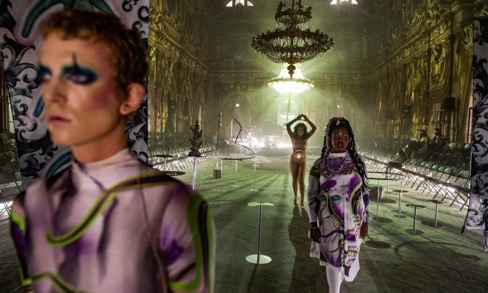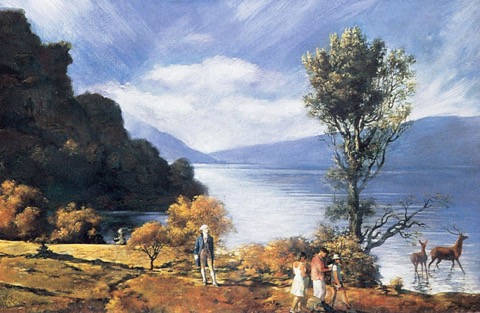
Education as the incubator of future opera practices
Outside of the vast amount of opera productions in the established opera houses (Germany on its own had 7082 opera performances in one saison 2017-18), there is a growing alternative practice outside the big houses. As an example, the O. Festival in Rotterdam (formerly the Operadagen) features a vast amount of hybrid opera practices. Telling different stories in different ways to a different audience… Flirting with the ever expanding boundaries of Opera as an art form. These new practices revitalise opera, and reach out to new audiences in new spaces.
'A Revue' by Benjamin Abel Meirhaeghe © 2020 Fred Debrock
It should be noted how quickly these 'outsider' projects are picked up in a regular opera circuit. The first hybrid opera 'A Revue' by the young performance artist Benjamin Abel Meirhaeghe, in 2020 got raving reviews, and was chosen as one of the ten best theatre productions in Flanders. It was immediately coproduced by Flanders Opera, among many others. Benjamin Abel Meirhaeghe is now part of the new artistic team of Toneelhuis, the biggest theatre company in Flanders.
Education prepares the future, building upon todays craftsmanship. Higher Opera Education Institutes should provide a creative space for the development of this future. It should train new tools needed for a different practice, alongside the craftsmanship inherited by tradition.
• Reconnecting to socio-cultural diverse, new audiences, in unexpected spaces
The world became more diverse, inclusive and has new pre-occupations (social and cultural): these evolutions should be reflected in a new opera practice. This is a challenge for an opera education focussing on a faithful re-enactment of the past. The real challenge is to relink this past to todays society.
It’s also important to allow things, to make people dare do things. We need to experiment. We cannot stick to convention, like it’s always been done. The complexity of the new music is also something that singers sometimes run away from, not only the use of voice. The way contemporary music is presented is sometimes repelling the students to join. Maybe we should tackle: first bring this music in, so language is not new anymore. And to give free space to body and voice, to find the pure space where you express yourself. Also important that she stressed the conversation of the singer with the composer. That there should be dialogue.
Bruno Pereira (ESMAE Porto), during the ISP Porto
Outside the classic opera houses, new opera practices are being developed, attracting new audiences that would it find hard to visit a classic opera house. This again requires the development of new formayts, adapted to new spaces, close to the socio-cultural environment of new audiences. These formats could help to build bridges towards the rich diversity of opera practices. Higher Education Institutes could encourage projects that look beyond the walls of opera houses, and create new hybrid forms of opera. Here again, by collaborating with other art practices - community theatre, rap concerts etc. - opera can show its intermedial strength again.
“Focusing on how an artistic experience can face an experience of a landscape, develop new cultural and nature experiences and create new stage room and meeting places. The terms of the interaction between the audience and the actors change radically when one stops to consider the landscape as background/scenography for a stage event or performance and instead using the landscape ́s characteristics and historical layers involving the location with people, resources, history, heritage, and gives the audience /participants relationship and status as co-creators. Thus, enabling visitors and audience to transform into participants and co-creators, and what changing clearly the mean of performance for artists and participants.”
Sara Erlingsdotter (SADA Stockholm) and António Salgado (ESMAE Porto)
In this new borderline performative context, Landscape becomes more than just a physical domain, a view, or a ‘scenery’ where artistic and cultural performances are played or re-presented to audiences. It becomes a meeting-place where the interaction between the performer, the audience and the structure of the work being performed is radically altered; a semiotic process in which all participants become expressively engaged in an act of deliverance and mindfulness, politically interventive and capable to enable radical transformations of the communities’ life, of the space/time of their existence and, not less essential, of their development and emancipatory processes. It is, subsequently, a new significance process where music and musical structure, written and/or improvised, may be engaged within a completely new relationship between performer, dramaturgy, audience and Land-Scape-Substratum.
António Salgado (ESMAE Porto)
In-Between Time and Space
• Exploring new spaces and new economic models: both physical as online spaces. Developing new cultural and nature experiences and create new stage room and meeting places
“Social space is considered as a scenic space, with the ability to trigger ephemeral events and to give us clues about the way individuals project and organize their personal path and make sense of their lives, by reinventing them. Today’s new artistic proposals give rise to a plethora or real and virtual spaces with the potential to become scenic spaces. In this sense, the social space has become a privileged place for artistic production and for theorization in the field of social sciences. As such, space can be understood as an open narrative structure that reflects individual opinions and dramaturgies that, in turn, will contextualize a specific social moment. Thereby, we can put forward the idea that social and interpersonal memories play a crucial role in the creation of the scenic space. This is based on the assumption that the public space is a space where acting and performance are in strict connection with the artistic and operatic discourse.”
Claudia Marisa, António Salgado, ESMAE)
• Stimulating out of the Black-Box – New and Alternative Circuits of Opera Making. These practices will inspire and influence the ‘middle-of-the-road’ stagings of repertoire opera’s.
Within the proliferation of alternative circuits of contemporary making opera which purpose is to come closer to the audience by getting out of the black box into the urban or nature landscape, creating by this gesture the possibility of crossing information with the landscape’s historical background, the public’s own history and the opera performative content; and by doing this giving the public the oper(a)tunity of being participative, not just by listening or thinking while they ‘comfortably’ seated on a theater chair, but actually by being participative as a part of the opera itself.
Out of the Black-Box – New and Alternative Circuits of Opera Making“Opera has been facing, since its birth, challenges and transformations that are consequence of the positive or negative interaction with the socio-cultural and artistic context of each moment in history. Surprisingly, in the last decades, there is a feeling that opera is losing the ability to rethink itself in line with the referred artistic and socio-cultural context of our contemporaneity. In the midst of the major opera houses in Europe we read statistics that point to the continuation of the demand for the Grand Opéra, with monumental interpretations within Opera Tradition. However, the proliferation of an alternative circuit around the opera is evident, with new repertoire being created or with bold approaches to an existing repertoire. Once again, the socio-cultural, artistic and also economic context is playing, of course, an important role in this gradual transformation.”
• Creating engaged singers. Opera is a political art.
Opera as an art is in an ongoing search of relinking itself with society, it would help if engaged singers (and musicians, director, stage designers, conductors…) brought society within the opera. Even if opera would be some kind of a pre-heaven for the elderly rich and famous (which it sometimes is in the fantasy of people who never entered the opera), it is a quite influential space. As an art, it should continue to ask the relevant questions on stage.
Even if an immediate revolution is out of reach in some of the most conservative Opera houses, it can and should be prepared outside of them, in alternative operatic formats. These will turn out to be vital of the survival of that same opera house, refusing to relink with society. In this revolution, it would be nice to avoid the head-chopping part, but to use an immensely rich tradition as building blocks for a relevant and extremely diverse art form. After al, this tradition was build by small revolutions of engaged artists.
This makes Opera a very political art form. It is one of these rare ‘high-brow’ art forms where approval and disapproval is vocalised very explicitly. A challenging staging at Bayreuth guarantees a stampede of reactions at the applause (and Booing), rivalling a football game. I vividly remember the applause of a regular performance of C(H)OEURS, an operatic performance directed by Alain Platel at Teatro Real de Madrid. Animated (and quite heated) discussions erupted at the third balcony between fan’s and foes of the piece, continuing onto the streets long after the presentation. Controversy between the new and the old is at the heart of the opera practice. That has always been the case. One shouldn’t take these musical revolutions lightly - after all Belgium was founded on an opera presentation.
Peter Missotten (technologydrivenart.org ZUYD)
Opera as an Intermedial Art
• More real-world/down-to earth/market activity modelling within the school
Every renewal - and even a revolution - needs a good plan and some entrepreneurial skills. As an art, opera should is not exclusively driven by demand: it thrives on its exciting proposals by engaged artists to the public, not really knowing what to expect. A good thumb of rule of what the spectator expects: Surprise us us, but don't scare us to death. That happens to be the golden rule in good marketing.
This adagio puts opera again in the middle of society. All progress - from Tangerine Blue iMacs, over strangely coloured washing tabs to button-less smartphones… just to name a few - was in essence driven by new exciting proposals nobody asked for. This contemporary and engaged form of entrepreneurship has always been at the heart of art (and Art). It's time Higher Opera Education Institutes upgrade their curriculum and incorporate new exciting visions on the marketing and production of the future. After all, we're not training accountants of the past

Komar & Melamid, America’s Most Wanted, 1994.
Photo by D. James Dee. Courtesy of the artists and Ronald Feldman Gallery, New York.
This painting was based on a questionaire on what Americans wanted their ideal painting to look like.
In 1994.